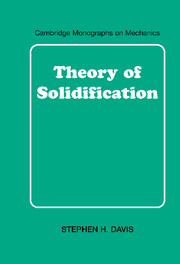7 - Dendrites
Published online by Cambridge University Press: 20 January 2010
Summary
Chapter 2 addresses nucleate growth. It was found that a spherical nucleus in an undercooled liquid will melt and disappear if its radius R is smaller than the critical nucleation radius R*. In this case, the curvature is so large that surface energy effects dominate those of undercooling. When R > R*, the sphere will continue to grow, and, as time increases, the effects of surface energy will decrease. When R reaches Rc, a morphological instability causes the spherical interface to become unstable to spatially periodic disturbances, leading to the growth of “bumps” on the interface. Experimental observation shows that the “bumps” grow, become dendritic, and continue to grow until they impact each other or a system boundary. Figure 7.1 shows a single bump that has become dendritic.
The term dendrite does not seem to have an accepted definition in the literature though it does refer to a treelike structure. Here it will be used to denote a two- or three-dimensional structure with side arms. Cells can, as well, be either two- or three-dimensional.
Dendritic growth is likely the most common form of microstructure, being present in all macroscopic castings. In fact, unless limitations of speed (or undercooling) are taken, a melt will usually freeze dendritically. If a sample of dendritically structured material having coarse microstructure is reprocessed, it will crack or otherwise produce defects. However, if the microstructure were fine enough, the reprocessing could proceed without ill effects. In either case, the “ghost” of the dendrites will remain after reprocessing.
- Type
- Chapter
- Information
- Theory of Solidification , pp. 215 - 254Publisher: Cambridge University PressPrint publication year: 2001
- 1
- Cited by

